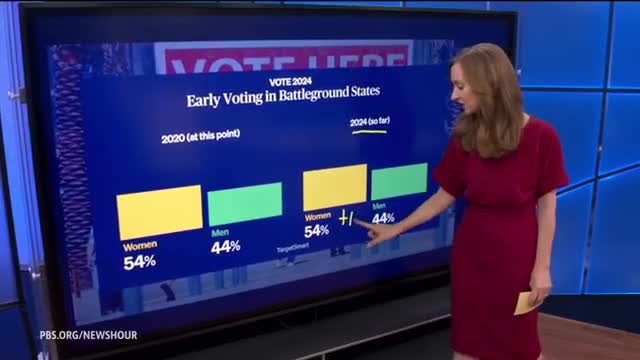Early voting trends reveal shifting dynamics in key states
This article was created by AI summarizing key points discussed. AI makes mistakes, so for full details and context, please refer to the video of the full meeting. Please report any errors so we can fix them. Report an error »

In a recent analysis of early voting trends, the Harris campaign is optimistic about its support among women, as polls indicate a strong turnout in this demographic. Historical data suggests that a higher proportion of women voting could benefit Harris, reminiscent of the gender gap that played a crucial role in Joe Biden's 2020 victory.
However, early voting patterns this year reveal a notable shift, particularly among rural voters. Compared to 2020, rural voters are making up a larger share of the early vote, a trend attributed to former President Trump's efforts to mobilize conservative voters in these areas. This raises questions about whether these voters are new participants or simply casting their ballots earlier than usual.
Current data from states that disclose party identification shows a competitive early voting landscape, with Democrats accounting for 39% and Republicans for 36% of early votes. This marks a significant narrowing of the Democrats' previous advantage in early voting.
In Pennsylvania, a key swing state, Democrats previously enjoyed a 3-to-1 early voting advantage, which has now decreased to 2-to-1. Republicans are encouraged by this shift, although some experts caution that these early Republican voters may not represent a surge of new participants.
Concerns are also emerging in Nevada, where Republicans are reportedly voting early in greater numbers compared to the last election cycle. This trend has raised alarms among Democrats, who are closely monitoring the situation as the election approaches. The dynamics of early voting in these critical states could have significant implications for the upcoming election.
However, early voting patterns this year reveal a notable shift, particularly among rural voters. Compared to 2020, rural voters are making up a larger share of the early vote, a trend attributed to former President Trump's efforts to mobilize conservative voters in these areas. This raises questions about whether these voters are new participants or simply casting their ballots earlier than usual.
Current data from states that disclose party identification shows a competitive early voting landscape, with Democrats accounting for 39% and Republicans for 36% of early votes. This marks a significant narrowing of the Democrats' previous advantage in early voting.
In Pennsylvania, a key swing state, Democrats previously enjoyed a 3-to-1 early voting advantage, which has now decreased to 2-to-1. Republicans are encouraged by this shift, although some experts caution that these early Republican voters may not represent a surge of new participants.
Concerns are also emerging in Nevada, where Republicans are reportedly voting early in greater numbers compared to the last election cycle. This trend has raised alarms among Democrats, who are closely monitoring the situation as the election approaches. The dynamics of early voting in these critical states could have significant implications for the upcoming election.
View full meeting
This article is based on a recent meeting—watch the full video and explore the complete transcript for deeper insights into the discussion.
View full meeting